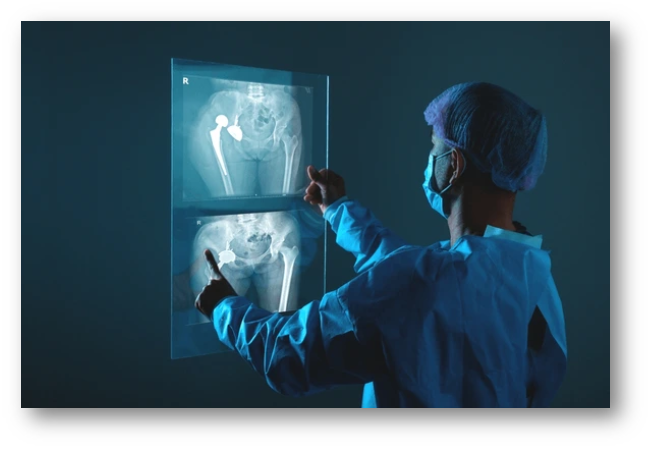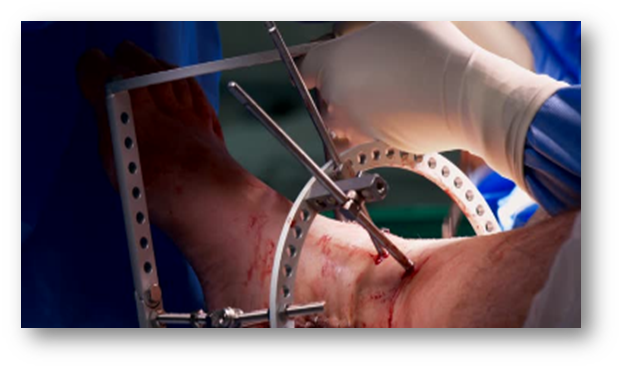
Orthopedic fractures are complex and require solutions that provide stability and safety to ensure complete recovery. The hybrid fixation technique is a modern approach that helps manage complicated surgeries by combining internal and external fixation processes. This innovative approach promises stability to the fracture while minimizing damage to the surrounding tissues.
This technique merges the biomechanical advantages of internal implants with the adaptability of external systems, offering surgeons a tailored solution for challenging cases.
What is the Hybrid Fixation Technique?
Hybrid fixation technique integrates the external stabilization (pins, wires, frames) with internal equipment (plates, nails, screws) for fracture alignment. It intends to treat challenging fractures, particularly those that occur adjacent to the joints or in patients with osteoporosis.
Surgeons can achieve a balance between safety and stability through the use of these two methods. It will guarantee that fractures repair well while ensuring the least amount of trauma to the adjacent tissues. When treating high-risk fractures where conventional fixation techniques might not be adequate, this approach is especially helpful.
Components of the Hybrid Fixation Technique
Internal Fixation
Internal fixation provides sturdy support and stability by directly holding the fractured bone together. These titanium and stainless-steel implants (intramedullary nails, plates, screws) offer strength and increased biocompatibility, which promotes healing.

External Fixation
The external fixation system uses
orthopedic pins and wires, along with external frames to stabilize fractures. These help with adjustable stability while accommodating soft tissue injuries and minimizing surgical trauma.

When to Use Hybrid Fixation for Orthopedic Treatment?

Hybrid fixation is an adaptable technique in orthopedic surgery. It is an ideal approach for complex fractures where the conventional methods do not provide the needed safety or stability. The hybrid fixation is advised for:
Joint Fixation
Hybrid fixation plays a major role in joint fracture treatment. By combining internal and external fixation, this approach ensures recovery after minimally invasive surgery. Some of the few cases of joint fixation, wherein surgeons often prefer hybrid fixation, are:
-
Severely Compromised Knee Fracture: For severe knee fractures that involve major soft tissue compromise and complex fractures, the external frames used allow post-operative adjustments as healing progresses.
-
Acetabular Pelvic Fracture: Hybrid fixation offers crucial support while protecting surrounding tissues in the treatment of complex acetabular fractures. This treatment combines plates and screws with external support allowing for early mobilization and weight bearing.
-
Hip Fractures: The intertrochanteric and femoral neck fracture is the most common type of hip fracture that must be treated with hybrid fixation. This method allows for better healing and fewer complications, particularly in osteoporotic patients. The application of both techniques distributes the load while reducing the chances of implant failure.
Osteoporotic Fractures
-
The hybrid system merges materials of two different implants, such as titanium and stainless steel, to provide the needed mechanical strength to the fracture.
-
This combination lowers the risk of fracture by 30% in such patients, as osteopromotive ions release, which leads to bone formation.
Periarticular and Intra-Articular Fractures
-
Fracture in the periarticular and intraarticular areas involves damage to both joints and soft tissues, making conventional open surgery slightly riskier.
-
A combination of a locking plate and an external ring fixator is used to ensure proper joint alignment while causing no damage to the soft tissue.
-
Example: Proximal and distal tibial fractures
Complex and Comminuted Fractures
-
A case of severe comminution, where there is a major injury, is difficult to treat with a single fixation method. The hybrid fixation excels in such injuries with major bone loss.
-
By minimizing surgical exposure and rigid support of two fixation techniques, this method reduces infection risks and allows progressive corrections.
-
For example, in distal femur fractures, a hybrid system allows quick mobilization and shortens hospitalization chances by 40%. They also support bone transport techniques to fill defects without grafts.
Open Fractures with Soft Tissue Damage
-
The open fractures cause a significant risk of infection and soft tissue damage, demanding a less invasive technique for fixation. Hybrid fixation in such cases is done by allowing staged fracture management.
-
Firstly, wound care and infection control are handled using the external fixation device for temporary stabilization without causing any soft tissue compromise. After the soft tissue heals, intramedullary nailing or plating is performed for long-term bone alignment. For example, the Gustilo-Mendoza-Williams open fracture type III in the tibia requires vascular repair to regain limb movement. Fracture treatment using this staged approach reduces deep infection by 15%, which is crucial in such cases.
Nonunion and Malunion Cases
-
Hybrid fixation provided better mechanical stability and promoted bone healing in cases where a fracture was incorrectly recovered or not healed at all.
-
Example: Nonunion femur fracture is treated using a compression plate and external frame for better bone formation.
Polytrauma and Multi-fragmentary Fractures
-
Polytrauma includes multiple severe injuries due to high-impact trauma like car accidents, requiring integrative orthopedic care for fractures and organ damage. These multi-fragmentary fractures hinder treatment due to instability and soft tissue complications.
-
Hybrid fixation utilizes external frames for joint stability in diaphyseal and metaphyseal fractures. This approach allows the soft tissue to remain intact for patient recovery. At the same time, internal fixation implants like plates and screws help achieve anatomical alignment of highly fractured fragments.
Clinical Evidence Supporting the Outcomes of Hybrid Fixation

The clinical evidence highlights the best outcomes linked to hybrid fixation in managing complex fractures. A study reported major improvements in healing and patient comfort after this process, making it an ideal approach for many surgeons.
Clinical Findings:
-
Lower Reduction Rates: 85% of the patients achieved effective bone union without graft.
-
Better Functional Outcomes: Amazing functional results were observed in patients, which promises quicker rehabilitation.
-
Early Weight-Bearing: Many cases reported early weight-bearing, enhancing recovery times.
-
Increased Patient Satisfaction: Minimum complications and higher satisfaction rates were observed among the treated patients.
Numerous such studies provide strong evidence supporting the efficiency of hybrid fixation techniques in orthopedic medicine. Furthermore, findings from other studies consistently indicate reduced nonunion rates and better patient satisfaction.
What Are the Advantages of Hybrid Fixation?
There are many benefits associated with hybrid fixation, making it an ideal choice amongst many orthopedic surgeons. With both methods in the process, this technique provides the much-needed care for fracture healing. Here are some of the main benefits of hybrid fixation:
Minimally Invasive Process
There is lesser surgical trauma, which makes it ideal for open fractures with compromised tissue injury by ensuring zero infection risk.
Improved Stability
The strength of internal orthopedic implants adds rigidity along with support provided by external fixation devices for the optimal alignment of the fractured bone.
Early Movement Possible
It allows patients to hold weight and initiate joint movements sooner by reducing stiffness and improving recovery outcomes significantly.
Maintains Bone Vascularity
It reduces periosteal damage by preserving vascular blood supply and promoting bone healing and regeneration.
Biomechanical Benefits
Hybrid fixation improves the axial load distribution by lowering the stress on internal equipment and also enhances rotational stability through external fixation techniques. It promotes controlled micromotion at the fracture site, promoting callus formation and secondary bone healing.
Faster Healing and Better Recovery Rate
Early mobilization and weight-bearing capacity of patients in this technique reduces the average healing time compared to when these methods are used individually. Patients treated using the hybrid fixation method benefit from shorter hospital stays and earlier return to function, allowing better outcomes. This approach is essential in cases of high-impact injury.
| Parameters |
External Fixation |
Internal Fixation |
Hybrid Fixation |
| Soft Tissue Integrity |
Excellent |
Limited |
Excellent |
| Load Distribution |
Distributed |
Focused |
Balanced |
| Infection Risk |
High (extended use of the device) |
Low to Moderate |
Low |
| Flexibility to Adjust |
High |
None |
High |
| Recovery Process |
Dynamic Healing |
Rigid Stability |
Controlled Healing |
| Recovery Timeline |
Gradual and Slow |
Fast |
Accelerated |
Challenges and Obstacles in the Hybrid Fixation Method
When executing the hybrid fixation techniques, the surgeons may face a few difficulties and challenges that must be addressed appropriately:
-
Soft Tissue Pressure: The external frames exert pressure on the adjacent soft tissue, which can cause skin breakdown in some cases. Hence, regular assessment by the orthopedic surgeon is important.
-
Pin Site Infection: Continuous cleaning of the pin sites is necessary to prevent infections.
-
Complicated Surgical Technique: The efficient application of hybrid fixation requires accurate surgical planning and execution. Thus, the surgeons should be well-versed in the intricacies of the method.
These factors highlight the importance of thorough preparation and ongoing care in achieving optimal outcomes with hybrid fixation.
Sharma Orthopedic: Redefining Fracture Care with Advanced Hybrid Fixation Solution
Transforming fracture management is our focus, and we fulfill this with our extensive range of innovative equipment created for an effective hybrid fixation technique. By combining advanced orthopedic implants with mechanical strength and biocompatible properties, our product range promotes the healing process for all complicated fractures.
Our hybrid fixation solutions stabilize fractures efficiently and also promote quicker recovery times and better patient results. As a trusted leader in orthopedic implant manufacturing, we commit to helping orthopedic surgeons by providing them with implants that promise optimal care and convenience. Visit the website to explore our range of premium hybrid fixation solutions today and experience the difference that we make in orthopedic medicine with our product quality!